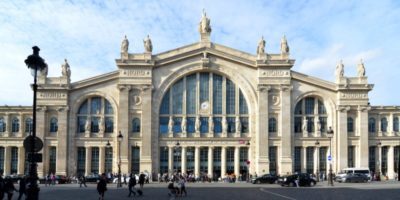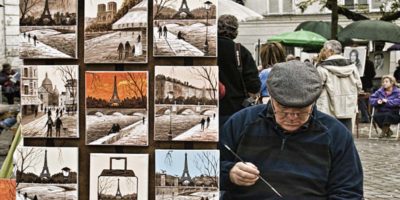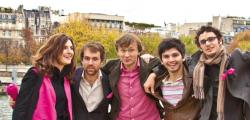
Image by Michelle Raponi from Pixabay
10 Most Beautiful Streets to see in Florence
Florence, the capital of Italy’s Tuscany region, is home to many masterpieces of Renaissance art and architecture.
One of its most iconic sights is the Duomo, a cathedral with a terracotta-tiled dome engineered by Brunelleschi and a bell tower by Giotto.
The Galleria dell’Accademia displays Michelangelo’s “David” sculpture.
The Uffizi Gallery exhibits Botticelli’s “The Birth of Venus” and da Vinci’s “Annunciation.
Arguably one of the most beautiful cities in Italy, Florence is full of incredible architecture, great food and historic significance that will keep you going for days.
In fact, there are so many things to do in Florence that it is almost certain you will need more than just one visit.
There are a lot of beautiful streetscapes, beautiful buildings, and beautiful views of the hills above much of the historic centre.
Additionally, there are many fascinating old streets, lined with magnificent ancient palaces built by some of the most interesting families that ever lived.
And the best part is that it is entirely accessible on foot! Florence, in fact, despite being a European capital, is one of the top walkable cities in the world
Let’s walk through 10 of the most beautiful streets in Florence.
1. Lungarno Torrigiani

Image by Txllxt Txllxt from Wikimedia
Lungarno Torrigiani is the stretch of the south bank of the Arno river in Florence that goes from Via de ‘Bardi to the Ponte alle Grazie.
From the Lungarno, there’s an extraordinary view of the Uffizi, the Vasari Corridor and Ponte Vecchio.
The Lungarno takes its name from the Torrigiani family, who owned Palazzo Tempi for a certain period.
While here explore The Lungarni, which are the other streets along the River Arno on the south side of the river, running west from the Lungarno Benvenuto Cellini along the Lungarno Serristori.
2. Via Maggio

Image by sailko from Wikimedia
Its name is an abbreviation of via Maggiore (“Maior” in Latin) for a reason.
The street is a hub of art, culture and creativity has always been the heart and soul of this neighbourhood and an important part of the city’s history.
Via Maggio is situated in the Oltrarno area and is a continuation of Via Tornabuoni but on the other side of the river.
It connects Ponte Santa Trinita with Piazza San Felice, in the Pitti Palace area.
Walking along the historic street you come across ateliers and antique shops.
Additionally, there are numerous old palaces that once belonged to Florence’s leading noble families, such as the Corsini, Pitti, Capponi and Ridolfi.
Walk the Via Maggio north from the Ponte Santa Trinita to the Via Romana and up to the Porta Romana gate.
Take in the ancient palaces with their coats of arms and wherever you can, peer into the courtyards.
Browse through all the museum-quality antiques being sold in the shops.
If you have a half-hour, take a look at the Museum of Natural History (“La Specola”) and its astonishing collection of wax models of human bodies.
3. Borgo San Jacopo
When Florence expanded outside the third city wall, several flourishing new streets were built, the so-called borghi: one of them, Borgo San Jacopo, is located in Oltrarno and has mantained until today its mediaeval structure.
Borgo San Jacopo is located between two bridges – Ponte Vecchio and Ponte a Santa Trinita.
Traverse the one street with three names – Borgo San Frediano, Via Santo Spirito, and Borgo San Jacopo – running east from the Porta San Frediano gate to the Ponte Vecchio.
View the palaces, ancient homes and workshops all forming a wonderfully typical Florentine vibe.
Get lost, wandering around the medieval maze.
4. Corridio Vasariano

Image is Diomidis Spinellis from Wikimedia
The Corridoio Vasariano has been closed since 2016 but will open in 2022 to visitors.
The Corridoio Vasariano was used by the Medici family and high-ranking officials to walk to Ponte Vecchio.
The rich did not interact with the poor and therefore had their own walkways.
The enclosed corridor above Florence begins at the Uffizi Gallery and goes along the Arno River to Ponte Vecchio where it reaches to Medicean Gardens of Boboli and the Grand-Ducal abode of Pitti Palace.
Once it opens again in 2022, it will be fully accessible with air conditioning and museums.
This is going to be a spectacular attraction in Florence and makes me want to go back just to see it.
The visit to the newly arranged Corridor will possible with a Corridio Vassariano special ticket.
5. Ponte Vecchio
The Vecchio bridge is the oldest bridge in Florence dating back to 1345.
One of the most famous bridges in the world doesn’t fail to impress visitors as it looks like it is from a fairy tale.
The Ponte Vecchio spans the River Arno and no trip to the city would be complete without walking across this iconic bridge in all of Europe.
On the night of August 3–4, 1944, toward the end of World War II, Nazi soldiers retreating from Florence blew up all the city’s bridges, except the Ponte Vecchio (Italian for “Old Bridge”).
A recently discovered letter, suggests that a brave shop assistant may have disabled the mines placed on the Ponte Vecchio, preventing its destruction.
The bridge has two levels, however, the upper floor is closed to the public and only opens for special events once or twice a year.
Along the lower level are shops where you can buy silver
6. Via Camillo Cavour

Image by Wilfred Krausse from Wikimedia
Via Camillo Cavour is one of the main roads in the northern area of the historic city centre of the Italian city of Florence.
It was created in 1861 from two older streets, Via Larga and Via Leopoldo (as far as Piazza della Liberta, renamed Piazzale Cavour at the same time) and renamed after Camillo Cavour on 17 June 1861, just 11 days after his death.
Camillo Paolo Filippo Giulio Benso, Count of Cavour, Isolabella and Leri, generally known as Cavour, was an Italian statesman and a leading figure in the movement towards Italian unification.
7. Viali di Circonvallazione

Image by Freepenguin from Wikimedia
The Viali di Circonvallazione are a series of 6-lane boulevards surrounding the north part of the historic centre of Florence.
The boulevards follow the outline of the ancient walls of Florence, which were demolished in 1865.
Giuseppe Poggi’s wanted to transform Florence then the capital of Italy a modern and big city like the other European capitals.
Parisian boulevard provided inspiration for Florence’s big boulevard.
8. Via de’ Tornabuoni

Image by Greenesol from Wikimedia
Via de’ Tornabuoni, perhaps the most famous shopping street in Florence, houses many of the top designer fashion houses in the city.
This elegant street, which runs from Piazza degli Antinori to Ponte Santa Trinita, has been synonymous with luxury shopping since the 19th century.
A trip to Via de’ Tornabuoni is not complete without a visit to the Museo Salvatore Ferragamo at the southernmost end of the boulevard; the museum honours the Italian brand and documents the shoe designer’s evolution as well as showcasing pieces from the 1930s to the present day.
The road was once crossed by the city’s Roman walls; in the early Middle Ages, it ran along the Mugnone river.
Near the current Palazzo Strozzi was the Brancazio Gate.
At the time, it had different names, including Via Larga dei Legnaiuoli and Via dei Belli Sporti.
Via de’ Tornabuoni once housed the Casoni Cafè, where, in 1920, the Negroni cocktail was invented by Camillo Negroni.
9. Via del Parione

Image by Txllxt Txllxt from Wikimedia
Those wishing to discover the artisanal side of Florence should stroll along Via del Parione.
Feted for its artisanal stores as well as its cool mix of modern boutiques, the street is a great place to discover unique gifts and souvenirs.
Visitors looking to invest in high-quality Italian leather should head straight to Il Bisonte.
The brand, which originated in Florence, offers stunning leather bags, suitcases and accessories.
For high-end vintage clothes and accessories, Elio Ferraro is an Aladdin’s cave of covetable goods.
10. Mercato di San Lorenzo

Image by Freepenguin from Wikimedia
San Lorenzo market is a great way of combining sightseeing with shopping in Florence.
The Mercato Centrale host a gourmet haven housed in a 19th-century building and offers an enticing selection of Italian and European food, including meats, fish, fruit and condiments.
The hundreds of exciting outdoor stalls that line the surrounding streets, including Via dell’ Ariento and Via Nazionale, are a great place to pick up souvenirs such as leather goods, accessories and pottery.
One of the best things to do in Florence is to take a guided tour for it is the perfect way to learn about Florentine history and to see the sights.
A walking tour is a good way to explore the city centre, while a driver with a local guide lets you see more in a short time.
There are so many historic buildings and museums presenting you with many options.
Planning a trip to Paris ? Get ready !
These are Amazon’s best-selling travel products that you may need for coming to Paris.
Bookstore
- The best travel book : Rick Steves – Paris 2023 – Learn more here
- Fodor’s Paris 2024 – Learn more here
Travel Gear
- Venture Pal Lightweight Backpack – Learn more here
- Samsonite Winfield 2 28″ Luggage – Learn more here
- Swig Savvy’s Stainless Steel Insulated Water Bottle – Learn more here
Check Amazon’s best-seller list for the most popular travel accessories. We sometimes read this list just to find out what new travel products people are buying.











